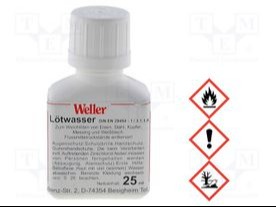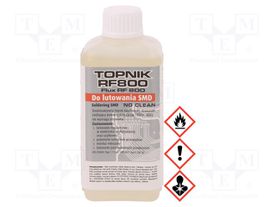Solder paste is mainly used during PCB assembly. Thanks to its ease of use, it has also become a big part of SMT assembly. The main work principles of solder pastes are the same but there are different grades and categories you should be familiar with before choosing the one you are going to work with.
What is solder paste?
Solder paste is a mixture of solder particles and flux. The flux is used as an adhesive which holds the solder particles together within the paste until the soldering process fuses the components together.
The solder particles were traditionally made of tin and lead but due to legislative changes, lead-based solders have been banned in most of the world. Nowadays there are many different alloy based solders available. The most common one used is tin and copper-based.
Classification of solder paste
As mentioned before, solder pastes have two main components - solder and flux. These are also the main points of classification for the product.
Flux classification
Rosin based fluxes - These solder pastes use rosin as a flux which is a natural extract from pine trees. Some of these fluxes do not have to be cleaned, depending on the product, but if required they can be cleaned using certain solvents.
Water-soluble fluxes - These are glycol-based solder pastes made of organic materials Since they are easily washed off, they give the product you’re working on a cleaner look but they do not offer any protection from re-oxidation
No clean fluxes - These solder pastes use resin-based materials with solid residue. Although they do not need to be cleaned, which saves one step from the production process, they need a very clean production environment.
Solder classification
The solder in solder pastes is classified by its size. As mentioned before, the solder particles are all spherical, regular in size and have a low level of oxidation. Since it’s very difficult to regulate particles that small, only 80% of the solder particles have to fall into the size gap determined by the solder paste type.
|
TYPE(IPC)
|
PARTICLE SIZE (μm)
|
|
TYPE 1
|
75-150
|
|
TYPE 2
|
45-75
|
|
TYPE 3
|
25-45
|
|
TYPE 4
|
20-35
|
|
TYPE 5
|
10-25
|
|
TYPE 6
|
5-15
|
|
TYPE 7
|
2-11
|
|
TYPE 8
|
2-8
|
Different alloys in solder paste
Tin has been used as the main material in soldering for a long time but usually with another material added to it. The melting point of pure tin is 231.9°C which is too high for some electronic components. An alloy is added to the solder to lower the melting point and improve other qualities, depending on the alloy.
Silver - Silver has many great qualities when it comes to soldering. It improves the wettability, strength, and fatigue resistance of the solder. The silver quantity in the solder should remain under 4% to get the full effect of the positive aspects without the solder spheres becoming fragile.
Zinc - Price-wise, zinc is similar to lead. It lowers the melting point of the solder but the downside of using zinc is that it reacts with oxygen, creating oxide in the solder. This lowers the wettability and overall quality of the solder.
Copper - Adding copper to solder has two positive effects - it makes the solder more rigid and less prone to corrosion
Indium - Indium is mainly used in solder to drastically lower the soldering temperature. A mixture of indium, tin, and silver can reach a melting point as low as 114°C. This makes Indium a great choice for soldering components that require very low temperatures. The downside of it is the cost. Indium is a very rare material that makes using it on a bigger scale very expensive.
Bismuth - Bismuth is also mainly used to lower the soldering temperature. A mixture of tin and bismuth can reach a melting temperature as low as 138°C. The main issue with bismuth is its fragility. To combat that, silver is also added to the mixture, which increases the melting point but improves the overall soldering quality.



